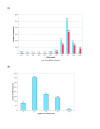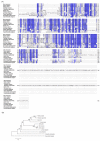Transcriptome analysis of the central nervous system of the mollusc Lymnaea stagnalis
- PMID: 19775440
- PMCID: PMC2760584
- DOI: 10.1186/1471-2164-10-451
Transcriptome analysis of the central nervous system of the mollusc Lymnaea stagnalis
Abstract
Background: The freshwater snail Lymnaea stagnalis (L. stagnalis) has served as a successful model for studies in the field of Neuroscience. However, a serious drawback in the molecular analysis of the nervous system of L. stagnalis has been the lack of large-scale genomic or neuronal transcriptome information, thereby limiting the use of this unique model.
Results: In this study, we report 7,712 distinct EST sequences (median length: 847 nucleotides) of a normalized L. stagnalis central nervous system (CNS) cDNA library, resulting in the largest collection of L. stagnalis neuronal transcriptome data currently available. Approximately 42% of the cDNAs can be translated into more than 100 consecutive amino acids, indicating the high quality of the library. The annotated sequences contribute 12% of the predicted transcriptome size of 20,000. Surprisingly, approximately 37% of the L. stagnalis sequences only have a tBLASTx hit in the EST library of another snail species Aplysia californica (A. californica) even using a low stringency e-value cutoff at 0.01. Using the same cutoff, approximately 67% of the cDNAs have a BLAST hit in the NCBI non-redundant protein and nucleotide sequence databases (nr and nt), suggesting that one third of the sequences may be unique to L. stagnalis. Finally, using the same cutoff (0.01), more than half of the cDNA sequences (54%) do not have a hit in nematode, fruitfly or human genome data, suggesting that the L. stagnalis transcriptome is significantly different from these species as well. The cDNA sequences are enriched in the following gene ontology functional categories: protein binding, hydrolase, transferase, and catalytic enzymes.
Conclusion: This study provides novel molecular insights into the transcriptome of an important molluscan model organism. Our findings will contribute to functional analyses in neurobiology, and comparative evolutionary biology. The L. stagnalis CNS EST database is available at http://www.Lymnaea.org/.
Figures







Similar articles
-
Transcriptome analysis provides genome annotation and expression profiles in the central nervous system of Lymnaea stagnalis at different ages.BMC Genomics. 2021 Sep 3;22(1):637. doi: 10.1186/s12864-021-07946-y. BMC Genomics. 2021. PMID: 34479505 Free PMC article.
-
De novo sequencing and transcriptome analysis of the central nervous system of mollusc Lymnaea stagnalis by deep RNA sequencing.PLoS One. 2012;7(8):e42546. doi: 10.1371/journal.pone.0042546. Epub 2012 Aug 1. PLoS One. 2012. PMID: 22870333 Free PMC article.
-
An expressed sequence tag survey of gene expression in the pond snail Lymnaea stagnalis, an intermediate vector of trematodes [corrected].Parasitology. 2005 May;130(Pt 5):539-52. doi: 10.1017/s0031182004006791. Parasitology. 2005. PMID: 15991497
-
Transcriptome analysis of the Octopus vulgaris central nervous system.PLoS One. 2012;7(6):e40320. doi: 10.1371/journal.pone.0040320. Epub 2012 Jun 29. PLoS One. 2012. PMID: 22768275 Free PMC article.
-
A vasopressin-related peptide in the mollusc Lymnaea stagnalis: peptide structure, prohormone organization, evolutionary and functional aspects of Lymnaea conopressin.Prog Brain Res. 1992;92:47-57. doi: 10.1016/s0079-6123(08)61164-4. Prog Brain Res. 1992. PMID: 1302887 Review. No abstract available.
Cited by
-
Transcriptome of the Australian Mollusc Dicathais orbita Provides Insights into the Biosynthesis of Indoles and Choline Esters.Mar Drugs. 2016 Jul 20;14(7):135. doi: 10.3390/md14070135. Mar Drugs. 2016. PMID: 27447649 Free PMC article.
-
Functional shell matrix proteins tentatively identified by asymmetric snail shell morphology.Sci Rep. 2020 Jun 17;10(1):9768. doi: 10.1038/s41598-020-66021-w. Sci Rep. 2020. PMID: 32555253 Free PMC article.
-
Identification and characterization of the kynurenine pathway in the pond snail Lymnaea stagnalis.Sci Rep. 2022 Sep 16;12(1):15617. doi: 10.1038/s41598-022-19652-0. Sci Rep. 2022. PMID: 36114337 Free PMC article.
-
Neuro-endocrine control of reproduction in hermaphroditic freshwater snails: mechanisms and evolution.Front Behav Neurosci. 2010 Oct 21;4:167. doi: 10.3389/fnbeh.2010.00167. eCollection 2010. Front Behav Neurosci. 2010. PMID: 21088700 Free PMC article.
-
Dopamine-mediated calcium channel regulation in synaptic suppression in L. stagnalis interneurons.Channels (Austin). 2018 Jan 1;12(1):153-173. doi: 10.1080/19336950.2018.1457897. Channels (Austin). 2018. PMID: 29589519 Free PMC article.
References
-
- Yeoman MS, Pieneman AW, Ferguson GP, ter Maat A, Benjamin PR. Modulatory role for the serotonergic cerebral giant cells in the feeding system of the snail, Lymnaea. I. Fine wire recording in the intact animal and pharmacology. J Neurophysiol. 1994;72:1357–1371. - PubMed
-
- Straub VA, Staras K, Kemenes G, Benjamin PR. Endogenous and network properties of Lymnaea feeding central pattern generator interneurons. J Neurophysiol. 2002;88:1569–1583. - PubMed
-
- Winlow W, Syed NI. The respiratory central pattern generator of Lymnaea. Acta Biol Hung. 1992;43:399–408. - PubMed
-
- Syed NI, Bulloch AG, Lukowiak K. In vitro reconstruction of the respiratory central pattern generator of the mollusk Lymnaea. Science. 1990;250:282–285. - PubMed
-
- Syed NI, Winlow W. Coordination of locomotor and cardiorespiratory networks of Lymnaea stagnalis by a pair of identified interneurones. J Exp Biol. 1991;158:37–62. - PubMed
Publication types
MeSH terms
Grants and funding
LinkOut - more resources
Full Text Sources
Research Materials

